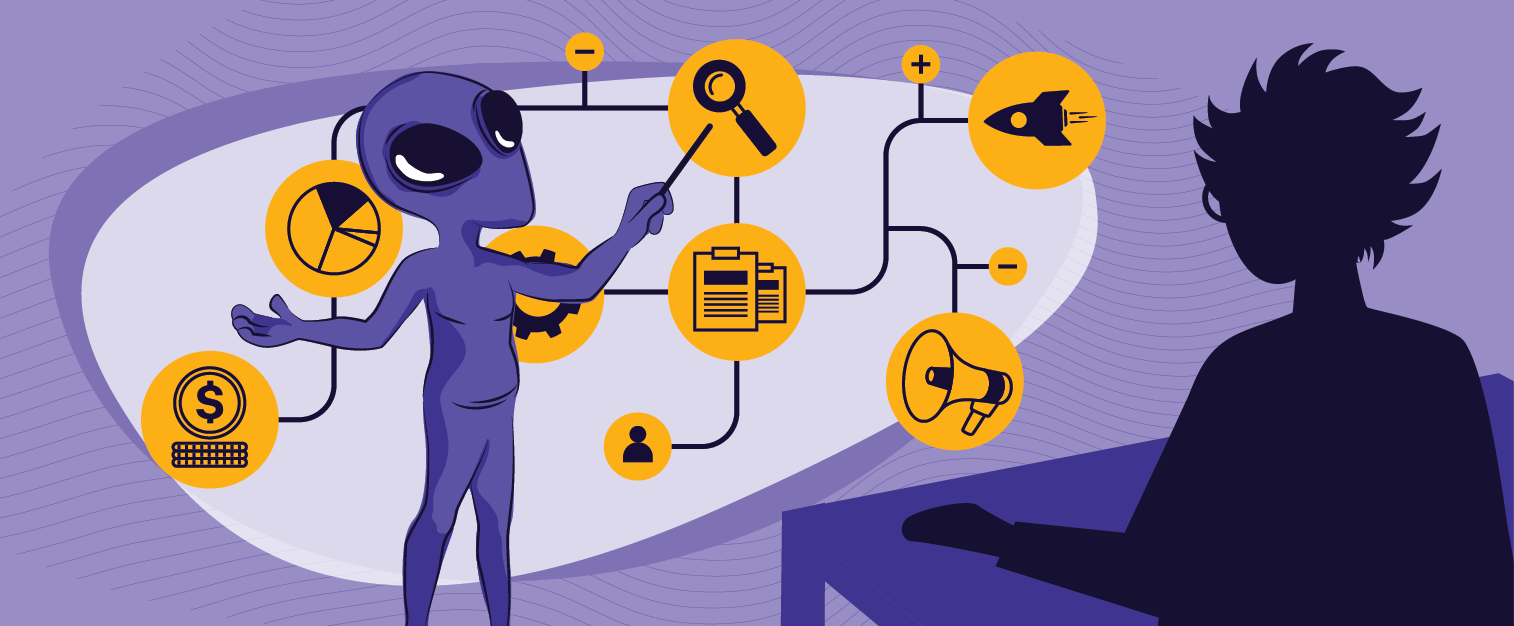Sending your data to our servers, please wait...





Oops... No results found.
Please try a different search phrase.
Paid Media 10 min read
How To Explain The Importance of Paid Media To Your Boss
Written by Ayesha Renyard
Content Writer @ Galactic Fed
Expert reviewed by Dallin Porter
Marketing Director @ Galactic Fed
Published 20 Jan 2021
In a study by Hubspot, 68% of marketers stated that paid advertising is “very important” or “extremely important” to their overall marketing strategy. If you’re reading this blog post, you’re probably amongst this 68%. This isn’t news to you.
But it might be for your boss. And if you’re looking to increase your marketing budget, you’re going to have to speak his or her language and demonstrate its impact on topline growth.
(And if your boss is anything like Michael Scott, this might be a challenge.)
Source: Giphy
As more businesses move online—and as users spend more time online—digital advertising is more important than ever for conversions. This is the year to make some paid media power moves.
So we say—make ‘em.
As part of our Paid Media Series, we’ve prepared the perfect pitch to acquire those extra marketing dollars and make those power moves.
And it starts with explaining what paid media is all about.
What is Paid Media?
To sell an idea, such as having a larger paid media budget, your boss needs to understand what paid media even is. If you just say, “paid media will make you rich,” you’re going to sound a lot like their friend from high school trying to sell them on a pyramid scheme.
So explain what paid media is and how it supplements your other media sources—owned and earned media. Set the stage for why it deserves time, effort, and money.
*Ahem*
At the core of most digital marketing strategies is gaining visibility because it supports more leads, sales, and signups. How do you do that? You use as many media channels as you can.
Some of it is owned media, or channels in your control, such as your company blog and your social media business accounts. Other media is earned—when customers, the press, or the public voluntarily share and discuss your content.
And then there’s paid media—a form of advertising that requires advertisers to pay third-party channels for media placements. This includes social media advertising, display advertising, and search engine advertising. (P.S. For a whole list of paid media terms, check out our glossary. You’ll sound like a pro slinging these terms at your next meeting.)
Source: Destination BC
Why is it an essential part of your strategy? Because it expands your reach beyond your audience (and their friends of friends). And with the help of ad networks’ AI technology, you’ll still be serving your ads to interested users. In other words, they’ll connect you to more potential customers.
Now that should pique your boss’ interest.
3 Reasons Why Paid Media is Important
Much like J.Lo, paid media is a triple threat: it builds brand awareness, generates more (high-quality) traffic, and ultimately increases revenue. Here’s how to explain it to your boss:
1. “Paid media will help us reach a larger audience, increase brand awareness, and build trust in our product.”
With the help of paid media, more people will be exposed to your brand. We all know the Marketing Rule of Seven: your prospective buyer needs to hear or see your marketing message at least seven times before they buy from you. And let’s be real—nowadays, with so many competing brands out there, that number is probably much higher.
In 2021 and beyond, it’s not just about creating a unique message. It’s about being heard. (As Gramps always says, “the squeaky wheel gets the grease!”). Paid media is important because it provides more outlets for you to shout your message from.
Tell them about: Facebook Brand Awareness campaigns
For brand awareness, explore the use of Facebook Ads. The platform has unparalleled data on its users, so your ads will be seen by audiences similar to yours—with the same habits and preferences. They also have Brand Awareness ad technology that you can leverage to help drive your campaign.
From analyzing hundreds of brand campaigns, Facebook Ads knows that the longer someone spends with an ad, the more likely they’ll remember what they’ve seen. This is called ad recall. If you run a Brand Awareness campaign, Facebook will present your ad to those who are more likely to watch and recall your ad and optimize the campaign accordingly.
And when people start recognizing a brand, they begin to trust it and consider it over competing brands. It’s a crucial step in the marketing funnel and bringing in new customers.
Source: The Fridge Agency
2. “Paid media will bring in more traffic to our website—made up of high-quality prospects.”
As the common phrase “quality over quantity” indicates, there’s an assumption that quality brings better results than quantity. But what if you could tell your boss that they could have quality and quantity? How would those results look?
Yes, paid media broadens your reach. But the ad networks today—such as Facebook Ads and Google Ads—also make sure your ads resonate with your target customer’s buyer persona. This keeps you (the paying advertiser) happy and provides a positive experience for the user. So if you sell charcuterie platters, you can rest assured that they won’t present your ads to vegans. Instead, they’ll show them to meat-eating women in their mid-30s who are dying to get away from their husband and toddlers and have a girls’ night. (Not to call anyone out or make presumptions…)
Simply put, paid media grows your traffic exponentially while maintaining the quality of the traffic. And because these prospects are more likely to convert, you can expect a higher conversion ratio.
Tell them about: Search ads
Search advertising displays ads in SERPs. Advertisers bid on certain keywords so that their ad can be at the top of the list when someone searches for that keyword. It’s very effective, as it’s based on the users’ explicit need, rather than just on implicit information about what they might be after or their typical behaviors and interests. We call these high-intent searches—and websites score many leads and conversions from this type of traffic. In fact, according to WordStream, paid ads score 65% of all clicks. And on average, 41% of clicks go to the top 3 paid ads on the SERP.
Source: PPC Expo
When it comes to search advertising, Google Ads is the cream of the crop of ad networks. In fact, Google claims that businesses generally make an average of $2 of revenue for every $1 they spend on Google Ads. Perhaps those numbers will make the benefits of a bigger ad budget clearer.
3. “Paid media will increase our revenue.”
No need to sugarcoat this one—it’s sweet enough as it is. At the end of the day, your boss will grade paid media’s importance on how well it increases revenue. So to seal the deal, demonstrate its role in acquisitions.
As we demonstrated above, paid media can play a role at all stages of the marketing funnel, which eventually leads to more conversions.
But you can also put your paid media efforts towards cold, hard conversions—such as sales and subscriptions. Sure, it’ll cost more. But if this cost is lower than the revenue gained from a sale or subscription, the return is pretty darn clear.
Source: Wordstream
Tell them about: Retargeting campaigns
You can also pay ad networks to retarget customers that leave your website without purchasing something. As interested as they may be, they also know that there are tons of options and competitors to consider. Or, they may just want some time to think about it and make sure it’s not an impulsive buy. (I, for example, have a hot tub sitting in my shopping cart—and I live in an apartment).
Just because prospects don’t make a purchase right away doesn’t mean they’re low-quality prospects. Sometimes they just need a little nudge.
One type of retargeting that is especially useful is pixel-based retargeting, which re-displays your material to any anonymous site visitor. Yep, you don’t need any form filled out or contact information from them. It’s a game-changer.
It works with the help of a JavaScript code (a pixel) that you place on your website or post-click landing page. After you attach the pixel, every time a visitor arrives (at your website or post-click landing page), the pixel drops an anonymous browser cookie in their browser.
When the visitor leaves your page and continues to browse other websites, the pixel lets the ad network you’re working with—like Google Ads or Facebook—know that these visitors need to start seeing your ads. Because the clickthrough rates are typically higher, retargeting ad clicks cost much less than search ads (like, up to 100 times less).
If you’re interested, check out this blog post on Facebook Pixel.
Don’t worry boss, it’s all measurable
To keep your boss at ease, let him or her know that paid media efforts are measurable. There’s no guesswork here. You can show them a report on just how well your campaign performed—and keep the marketing dollars flowin’.
Source: Giphy
If you need help setting up a brag-worthy paid media ad campaign, reach out to our Galactic Fed experts. We’ll help drive results that prove paid media’s place in your marketing campaigns— no ifs, and or buts.

Ayesha Renyard
Content Writer @ Galactic Fed



